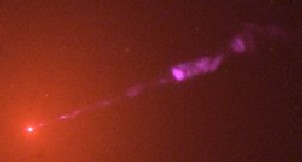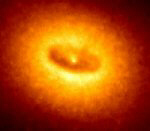Objectives
- Both the most predictable and the most powerful sources of gravitational waves emit their radiation predominantly at very low frequencies, below about 10 mHz;
- The 'background noise' which arises from the Earth's gravitational field at these frequencies is such that gravitational radiation from astronomical objects can only be detected by space-based instruments.
The LISA mission is designed to search for and detect gravitational radiation from astronomical sources. In the process, LISA can test some of the fundamental tenets of the theory of gravitation.
The most predictable sources
The most predictable sources of gravitational waves are binary star systems in our galaxy. LISA's observations of these systems would be of interest both for fundamental physics and for astrophysics. The LISA design is such that both the amplitude and also the polarization of gravitational waves can be measured. If gravitational radiation from known binary systems is not detected, or is detected with amplitudes or polarizations not predicted by general relativity, then general relativity must be wrong. If the sources are detected then the polarization measurement reveals the angle of inclination of the orbit of the binary system. This is a crucial missing factor from many optical observations of these systems, and is necessary in order to infer the mass of the stars in the binary pair.
There should be thousands of individually resolvable binary systems, including some already identified from optical and X-ray observations. Candidate sources include X-ray binary systems (including the low-mass X-ray binary 4U 1820-30), neutron star binaries, black hole binaries and helium cataclysmic variables to name but a few.
The most powerful sources
The most powerful sources of gravitational radiation are the mergers of super-massive black holes in distant galaxies; if they occur their signal power can be more than 10 million times the expected noise power in a space-based detector. Observations of signals involving massive black holes (MBHs) would test general relativity and particularly black-hole theory to unprecedented accuracy, and they would provide new information about astronomy that can be obtained no other way.
 |
|
A visible light image of the giant elliptical galaxy M87, taken with NASA Hubble Space Telescope's Wide Field Planetary Camera 2 in February 1998, reveals a brilliant jet of high-speed electrons emitted from the nucleus (diagonal line across image). The jet is produced by a 3000 million solar mass black hole. |
 |
|
An image of the core of the galaxy NGC 4261 taken by the Hubble Space Telescope. A black hole of about 5000 million solar masses resides at the centre. |
Fortunately for LISA, massive black holes are expected to be abundant, since all the confident detections of black holes are in local galaxies.
